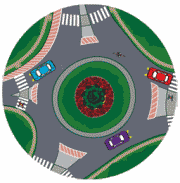You can catch it on iPlayer for the usual limited time. The One Show on BBC One tonight had a segment about driving on bald tyres. It starts at 2½ minutes in.
The programme says that around 60% of cars seen by garages (well, one in Northampton, so it’s reasonable to extrapolate a little) have at least one defective tyre. The claim is made that people are leaving it longer before replacing tyres due to the adverse economy we’re currently experiencing.
There’s nothing wrong with the segment overall, but it makes the highly misleading and erroneous claim that if your tyres fail the “20p test” they are illegal. I mentioned this test in several recent posts (for example here, and then again here. Oh, and here).
The One Show is absolutely wrong about this.
The legal minimum tread depth is 1.6mm across the middle ¾ of the tyre and all around the edge. The Highway Code confirms this:
Tyres. Tyres MUST be correctly inflated to the vehicle manufacturer’s specification for the load being carried. Always refer to the vehicle’s handbook or data. Tyres should also be free from certain cuts and other defects.
Cars, light vans and light trailers MUST have a tread depth of at least 1.6 mm across the central three-quarters of the breadth of the tread and around the entire circumference.
Motorcycles, large vehicles and passenger-carrying vehicles MUST have a tread depth of at least 1 mm across three-quarters of the breadth of the tread and in a continuous band around the entire circumference.
Mopeds should have visible tread.
Be aware that some vehicle defects can attract penalty points.
Indirectly, this is all the fault of the Cumbria Police and the media morons who reported their blitz on dangerous tyres ahead of this winter (that first article I wrote which mentioned the “20p test”). The rim on a 20p is about 2.5mm wide, and Cumbria Police were obviously using this as an overkill method of warning people who drive in the harsh Cumbrian winters on the tricky Cumbrian roads about the risks they were taking as their tyres wore lower and lower (driving in Cumbria in winter is not quite the same as driving in London or any other city during the same season).
To measure 1.6mm you can use the row of dots on a 10p piece (or buy a proper tool from Halfords for a couple of quid).
The One Show goes on to suggest that a tyre failing the “20p test” is dangerous – even saying that anything less than 3mm is illegal, and carrying out an unscientific test to prove their incorrect ideas.
Yes, we know that the lower the tread, the longer the stopping distance, but the fact remains that 1.6mm is still the legal minimum – not 3mm, as the BBC is falsely claiming. And although garages might refuse to MoT a car with less than 3mm of tread on its tyres, that’s not the same as them being illegal.
EDIT: This article is already attracting a lot of hits. A reader has commented that the car with the “dodgy tyres” doesn’t skid into the boxes – it rolls into them. This suggests that the test was perhaps rigged to give more dramatic results.
Obviously, we only have The One Show’s word that the tyres were at the tread depth the woman’s car had. Speculation, of course, but it makes you think.
Of course, the stopping distance is best with new tyres. But it gets greater with ANY amount of wear. The question is: at what point does it become dangerous? The law says below 1.6mm, and not 3mm.


 Don’t forget to put your clocks back by one hour at 2am tomorrow morning.
Don’t forget to put your clocks back by one hour at 2am tomorrow morning.